How to recognize phishing emails like the "DHL - Your Parcel Delivery Arrived Today" email
Phishing/ScamAlso Known As: DHL - Your Parcel Delivery Arrived Today phishing email
Get free scan and check if your device is infected.
Remove it nowTo use full-featured product, you have to purchase a license for Combo Cleaner. Seven days free trial available. Combo Cleaner is owned and operated by RCS LT, the parent company of PCRisk.com.
What kind of scam is "DHL - Your Parcel Delivery Arrived Today"?
We have examined this email and concluded that it is written by scammers who pretend to be DHL - a legitimate logistics company. The purpose of this scam email is to trick recipients into providing sensitive information. Emails of this type are called phishing emails. This fake DHL letter should be marked as spam and ignored.
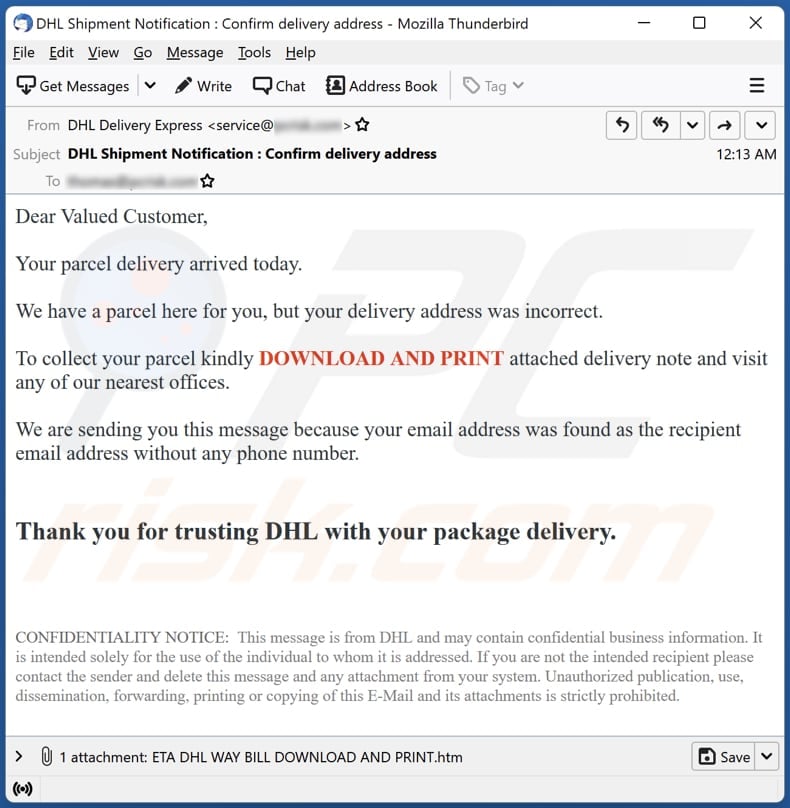
More about the "DHL - Your Parcel Delivery Arrived Today" scam email
This scam email is disguised as a DHL shipment notification requesting delivery address confirmation. It says that a parcel has arrived today but could not be delivered due to an incorrect address. It instructs recipients to download and print the attached "delivery note" and take it to the nearest DHL office.
The file attached to this email is an HTML file disguised as an MS Excel document. After opening that HTML file (a phishing page), users are prompted to sign in using their email address and password to confirm that they are not robots (to confirm their identities). The entered information is then sent to scammers.
Scammers use this phishing email (and the attached file) to trick recipients into providing login information. Usually, such information is sold to third parties and (or) used to steal online accounts. Depending on the type of hijacked accounts, scammers could use them to steal identities, deliver malware, steal money, access other sensitive information, and more.
| Name | DHL - Your Parcel Delivery Arrived Today Email Scam |
| Threat Type | Phishing, Scam, Social Engineering, Fraud |
| Fake Claim | A parcel has arrived but cannot be delivered due to an incorrect address. |
| Detection Names (Attachment) | Avast (HTML:PhishingMS-AIP [Phish]), Combo Cleaner (Generic.JS.FakeLogin.A.4BC09FF0), ESET-NOD32 (HTML/Phishing.Gen), Ikarus (Phishing.HTML.Doc), Microsoft (Trojan:Win32/Phonzy.C!ml), Full List Of Detections (VirusTotal) |
| Disguise | Letter from DHL company. |
| Symptoms | Unauthorized online purchases, changed online account passwords, identity theft, illegal access of the computer. |
| Distribution methods | Deceptive emails, rogue online pop-up ads, search engine poisoning techniques, misspelled domains. |
| Damage | Loss of sensitive private information, monetary loss, identity theft. |
| Malware Removal (Windows) |
To eliminate possible malware infections, scan your computer with legitimate antivirus software. Our security researchers recommend using Combo Cleaner. Download Combo CleanerTo use full-featured product, you have to purchase a license for Combo Cleaner. 7 days free trial available. Combo Cleaner is owned and operated by RCS LT, the parent company of PCRisk.com. |
Similar scam emails in general
Phishing emails are typically used to extract credit card details, login information (e.g., usernames and passwords), ID card information, social security numbers, or other details. It is common for these emails to be disguised as letters from legitimate companies, organizations, or other entities.
It is important to mention that scammers can try to use the obtained login information to access multiple accounts since users often use the same password for more than one account. Also, threat actors can use email not only to obtain personal information but also to deliver malware.
Examples of phishing emails are "Contract Document Email Scam", "Standard Bank Email Scam", and "You Have Blocked Emails Created Scam".
How do spam campaigns infect computers?
Emails used to deliver malware have files or links in them. Recipients infect computers via those files or links. However, not all files infect computers immediately after opening them. For instance, MS Office documents do not infect computers until users enable macros commands (editing/content), compressed files cannot infect computers until archive files are opened and their contents are executed, etc.
More examples of files used to deliver malware via email are PDF documents, JavaScript files, and ISO files.
How to avoid installation of malware?
Double-check emails containing links or attachments, especially when they are irrelevant and sent from unknown addresses. Download software from legitimate sources (official pages and stores) only. Do not trust advertisements on shady web pages. Keep the operating system and installed programs updated.
Use reputed antivirus software and scan a computer for threats regularly. If you've already opened malicious attachments, we recommend running a scan with Combo Cleaner Antivirus for Windows to automatically eliminate infiltrated malware.
Text presented in the "DHL - Your Parcel Delivery Arrived Today" email letter:
Subject: DHL Shipment Notification : Confirm delivery address
Dear Valued Customer,Your parcel delivery arrived today.
We have a parcel here for you, but your delivery address was incorrect.
To collect your parcel kindly DOWNLOAD AND PRINT attached delivery note and visit any of our nearest offices.
We are sending you this message because your email address was found as the recipient email address without any phone number.
Thank you for trusting DHL with your package delivery.
Screenshot of the attached HTML file requesting to sign in:
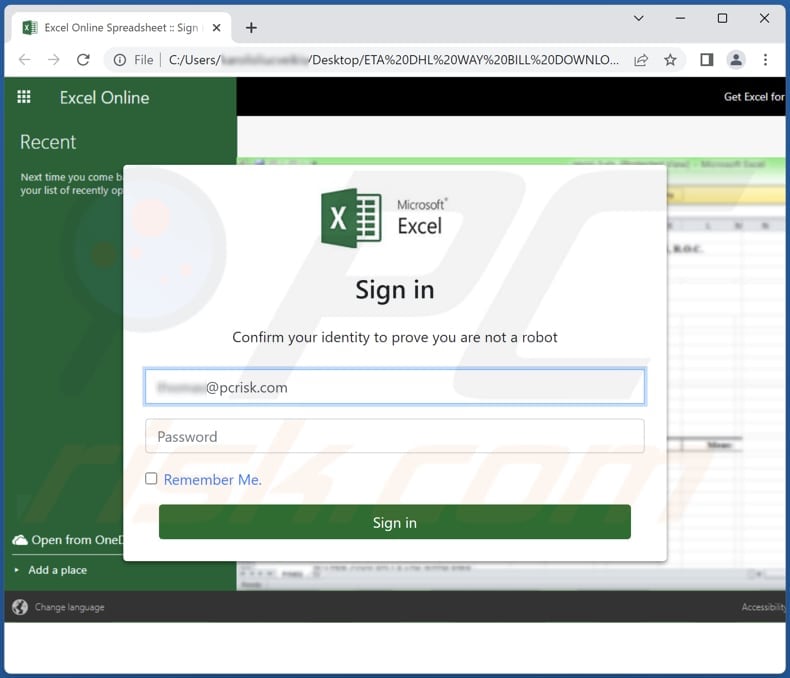
Another example of DHL parcel delivery-themed spam email promoting a phishing site:
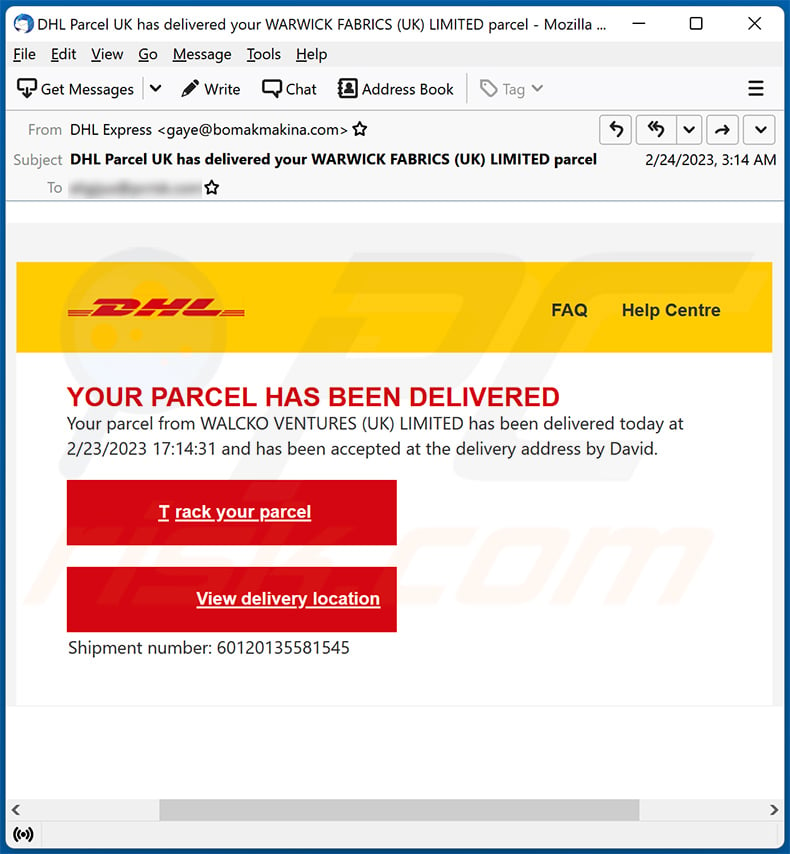
Text presented within:
Subject: DHL Parcel UK has delivered your WARWICK FABRICS (UK) LIMITED parcel
YOUR PARCEL HAS BEEN DELIVEREDYour parcel from WALCKO VENTURES (UK) LIMITED has been delivered today at 2/23/2023 17:14:31 and has been accepted at the delivery address by David.
T rack your parcel
View delivery locationShipment number: 60120135581545
Screenshot of the promoted phishing site:
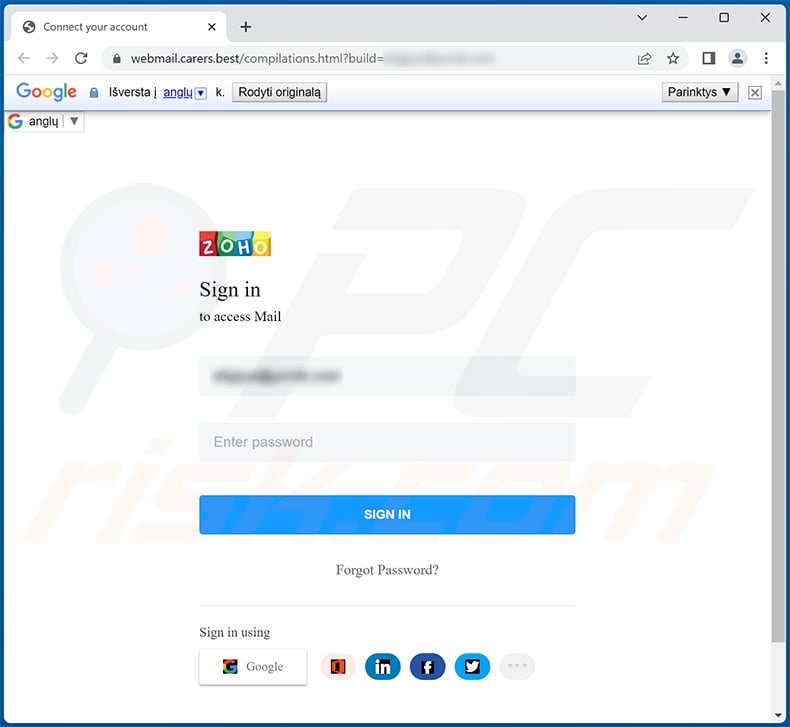
Another example of an email from "DHL - Your Parcel Delivery Arrived Today" spam campaign:
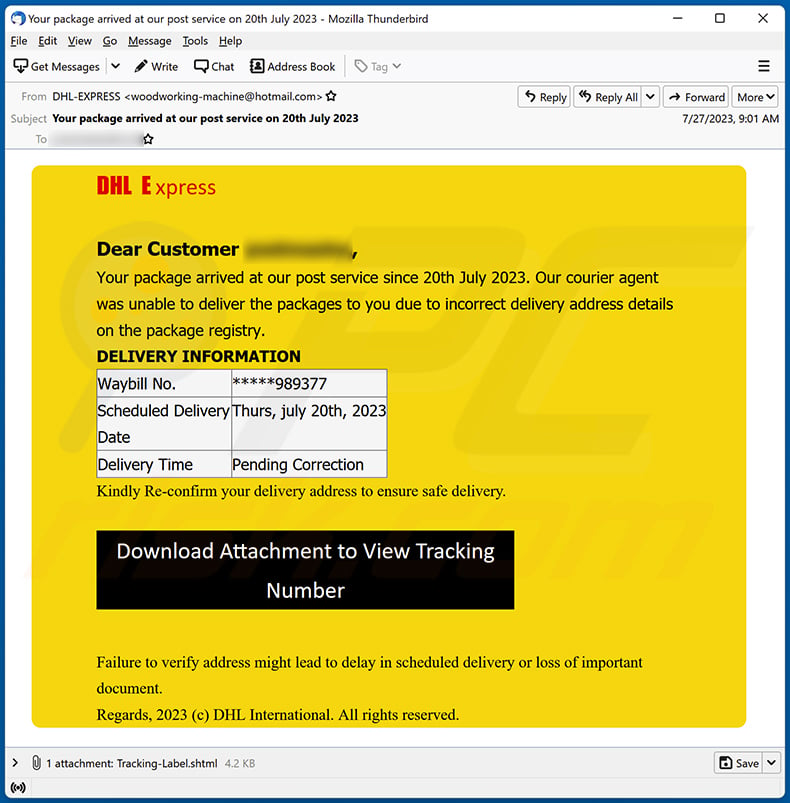
Text presented within:
Subject: Your package arrived at our post service on 20th July 2023
DHL E xpress
Dear Customer -,
Your package arrived at our post service since 20th July 2023. Our courier agent was unable to deliver the packages to you due to incorrect delivery address details on the package registry.
DELIVERY INFORMATION
Waybill No.
*****989377
Scheduled Delivery Date
Thurs, july 20th, 2023
Delivery Time
Pending CorrectionKindly Re-confirm your delivery address to ensure safe delivery.
Download Attachment to View Tracking Number
Failure to verify address might lead to delay in scheduled delivery or loss of important document.
Regards, 2023 (c) DHL International. All rights reserved.
Screenshot of the attached HTML file designed for phishing purposes:
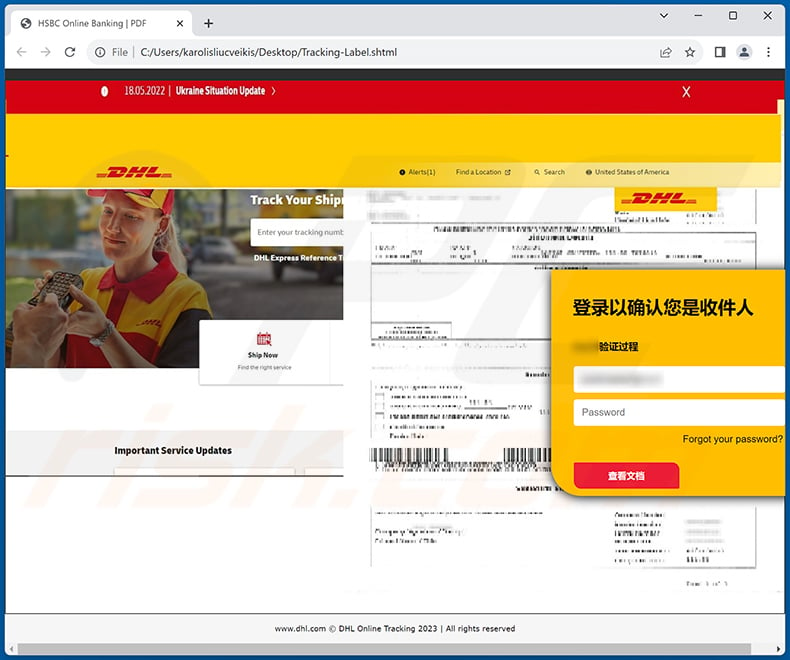
Another example of an email from "DHL - Your Parcel Delivery Arrived Today" spam campaign:
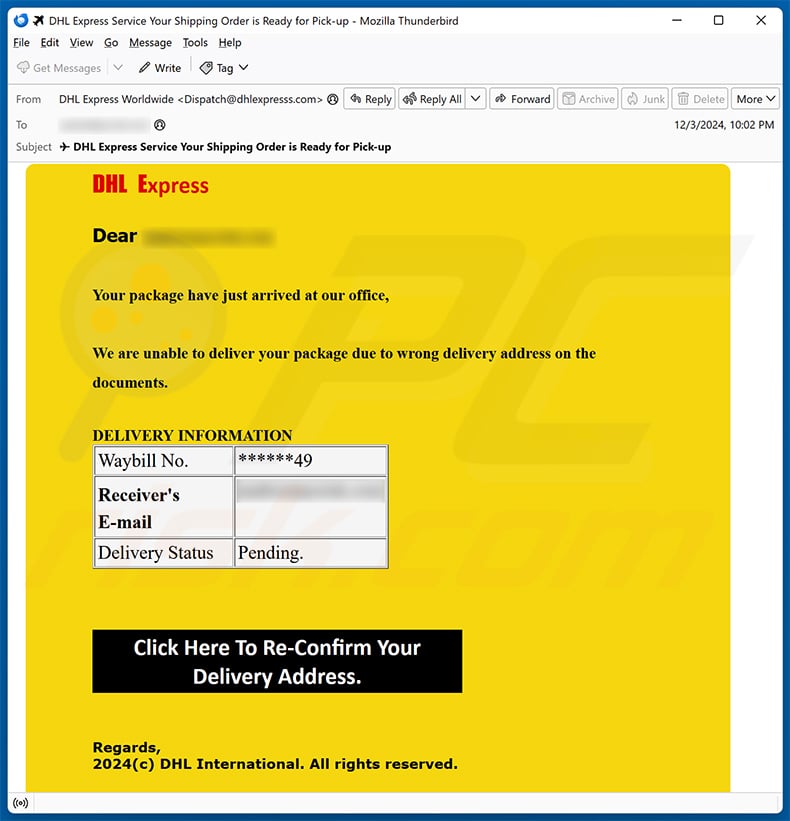
Text presented within:
Subject: DHL Express Service Your Shipping Order is Ready for Pick-up
DHL Express
Dear ********.
Your package have just arrived at our office,
We are unable to deliver your package due to wrong delivery address on the documents.
DELIVERY INFORMATION
Waybill No.******49
Receiver's E-mail********
Delivery StatusPending.
Click Here To Re-Confirm Your Delivery Address.
Regards,
2024(c) DHL International. All rights reserved.Pera Business Park Ltd. Company registered in England and Wales, No. 09998229. Registered address Nottingham Road, Melton Mowbray LE13 0PB. Pera Business Park Ltd. may monitor email traffic data and also the content of email for the purposes of security.
Yet another example of an email from "DHL - Your Parcel Delivery Arrived Today" spam campaign:
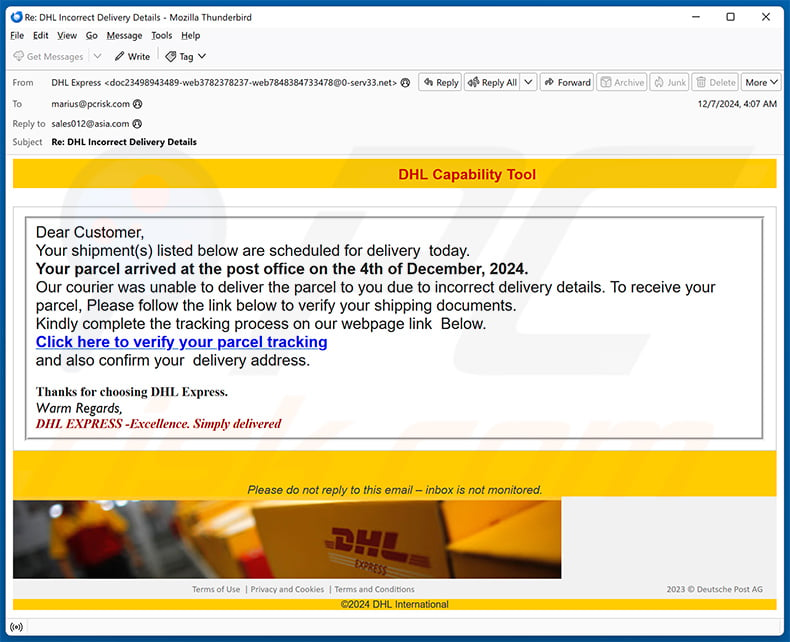
Text presented within:
Subject: Re: DHL Incorrect Delivery Details
DHL Capability Tool
Dear Customer,
Your shipment(s) listed below are scheduled for delivery today.
Your parcel arrived at the post office on the 4th of December, 2024.
Our courier was unable to deliver the parcel to you due to incorrect delivery details. To receive your parcel, Please follow the link below to verify your shipping documents.
Kindly complete the tracking process on our webpage link Below.
Click here to verify your parcel tracking
and also confirm your delivery address.
Thanks for choosing DHL Express.Warm Regards,
DHL EXPRESS -Excellence. Simply delivered
Instant automatic malware removal:
Manual threat removal might be a lengthy and complicated process that requires advanced IT skills. Combo Cleaner is a professional automatic malware removal tool that is recommended to get rid of malware. Download it by clicking the button below:
DOWNLOAD Combo CleanerBy downloading any software listed on this website you agree to our Privacy Policy and Terms of Use. To use full-featured product, you have to purchase a license for Combo Cleaner. 7 days free trial available. Combo Cleaner is owned and operated by RCS LT, the parent company of PCRisk.com.
Quick menu:
- What is DHL - Your Parcel Delivery Arrived Today phishing email?
- Types of malicious emails.
- How to spot a malicious email?
- What to do if you fell for an email scam?
Types of malicious emails:
![]() Phishing Emails
Phishing Emails
Most commonly, cybercriminals use deceptive emails to trick Internet users into giving away their sensitive private information, for example, login information for various online services, email accounts, or online banking information.
Such attacks are called phishing. In a phishing attack, cybercriminals usually send an email message with some popular service logo (for example, Microsoft, DHL, Amazon, Netflix), create urgency (wrong shipping address, expired password, etc.), and place a link which they hope their potential victims will click on.
After clicking the link presented in such email message, victims are redirected to a fake website that looks identical or extremely similar to the original one. Victims are then asked to enter their password, credit card details, or some other information that gets stolen by cybercriminals.
![]() Emails with Malicious Attachments
Emails with Malicious Attachments
Another popular attack vector is email spam with malicious attachments that infect users' computers with malware. Malicious attachments usually carry trojans that are capable of stealing passwords, banking information, and other sensitive information.
In such attacks, cybercriminals' main goal is to trick their potential victims into opening an infected email attachment. To achieve this goal, email messages usually talk about recently received invoices, faxes, or voice messages.
If a potential victim falls for the lure and opens the attachment, their computers get infected, and cybercriminals can collect a lot of sensitive information.
While it's a more complicated method to steal personal information (spam filters and antivirus programs usually detect such attempts), if successful, cybercriminals can get a much wider array of data and can collect information for a long period of time.
![]() Sextortion Emails
Sextortion Emails
This is a type of phishing. In this case, users receive an email claiming that a cybercriminal could access the webcam of the potential victim and has a video recording of one's masturbation.
To get rid of the video, victims are asked to pay a ransom (usually using Bitcoin or another cryptocurrency). Nevertheless, all of these claims are false - users who receive such emails should ignore and delete them.
How to spot a malicious email?
While cyber criminals try to make their lure emails look trustworthy, here are some things that you should look for when trying to spot a phishing email:
- Check the sender's ("from") email address: Hover your mouse over the "from" address and check if it's legitimate. For example, if you received an email from Microsoft, be sure to check if the email address is @microsoft.com and not something suspicious like @m1crosoft.com, @microsfot.com, @account-security-noreply.com, etc.
- Check for generic greetings: If the greeting in the email is "Dear user", "Dear @youremail.com", "Dear valued customer", this should raise suspiciousness. Most commonly, companies call you by your name. Lack of this information could signal a phishing attempt.
- Check the links in the email: Hover your mouse over the link presented in the email, if the link that appears seems suspicious, don't click it. For example, if you received an email from Microsoft and the link in the email shows that it will go to firebasestorage.googleapis.com/v0... you shouldn't trust it. It's best not to click any links in the emails but to visit the company website that sent you the email in the first place.
- Don't blindly trust email attachments: Most commonly, legitimate companies will ask you to log in to their website and to view any documents there; if you received an email with an attachment, it's a good idea to scan it with an antivirus application. Infected email attachments are a common attack vector used by cybercriminals.
To minimise the risk of opening phishing and malicious emails we recommend using Combo Cleaner Antivirus for Windows.
Example of a spam email:

What to do if you fell for an email scam?
- If you clicked on a link in a phishing email and entered your password - be sure to change your password as soon as possible. Usually, cybercriminals collect stolen credentials and then sell them to other groups that use them for malicious purposes. If you change your password in a timely manner, there's a chance that criminals won't have enough time to do any damage.
- If you entered your credit card information - contact your bank as soon as possible and explain the situation. There's a good chance that you will need to cancel your compromised credit card and get a new one.
- If you see any signs of identity theft - you should immediately contact the Federal Trade Commission. This institution will collect information about your situation and create a personal recovery plan.
- If you opened a malicious attachment - your computer is probably infected, you should scan it with a reputable antivirus application. For this purpose, we recommend using Combo Cleaner Antivirus for Windows.
- Help other Internet users - report phishing emails to Anti-Phishing Working Group, FBI’s Internet Crime Complaint Center, National Fraud Information Center and U.S. Department of Justice.
Frequently Asked Questions (FAQ)
Why did I receive this email?
Scammers behind this DHL-themed email sent the same letter to all recipients. This email is non-targeted.
I have provided my personal information when tricked by this email, what should I do?
If you opened the attached HTML file and provided your password, change your passwords as soon as possible.
I have downloaded and opened a file attached to this email, is my computer infected?
No, the file (HTML file) attached to this email is not malicious. However, emails can contain malicious files designed to infect computers.
I have read the email but did not open the attachment, is my computer infected?
It is safe to open emails even if they contain malicious attachments or links. No harm can be caused just by opening an email.
Will Combo Cleaner remove malware infections that were present in email attachment?
Yes, Combo Cleaner will scan your computer and remove detected threats. It can detect almost all known malware. If a computer is infected with high-end malware, then it should be scanned fully (using a full scan) since malware of this kind usually hides deep in the operating system.
Share:

Tomas Meskauskas
Expert security researcher, professional malware analyst
I am passionate about computer security and technology. I have an experience of over 10 years working in various companies related to computer technical issue solving and Internet security. I have been working as an author and editor for pcrisk.com since 2010. Follow me on Twitter and LinkedIn to stay informed about the latest online security threats.
PCrisk security portal is brought by a company RCS LT.
Joined forces of security researchers help educate computer users about the latest online security threats. More information about the company RCS LT.
Our malware removal guides are free. However, if you want to support us you can send us a donation.
DonatePCrisk security portal is brought by a company RCS LT.
Joined forces of security researchers help educate computer users about the latest online security threats. More information about the company RCS LT.
Our malware removal guides are free. However, if you want to support us you can send us a donation.
Donate
▼ Show Discussion